|
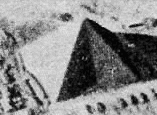 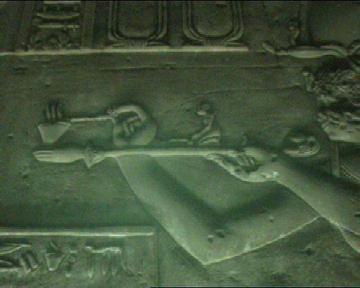 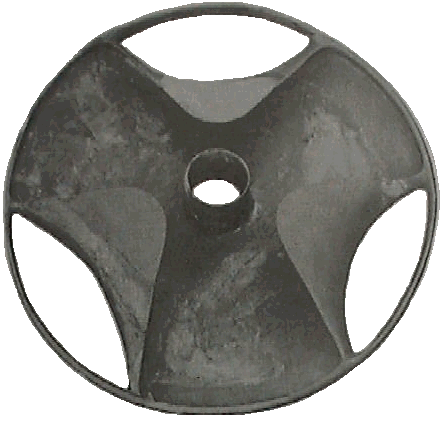   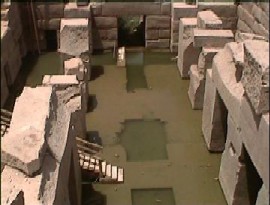
 Prehistoric Egypt:
Prehistoric Egypt:
|
Egypt was witness to
one of the most remarkable cultures in the
ancient world.
It is host to the last remaining wonder of
the ancient world, and is considered by many to be the place from
which modern civilisation arose.
Quick Links...
|
|
Prehistoric Egypt: Featured Items: |
|
The 'Lost
Labyrinth' of Egypt -
It was recently
announced that the lost labyrinth of Egypt at Hawara has been
re-discovered by an expedition funded by
NRIAG,
Ghent University/Kunst-Zicht
& Louis De
Cordier, with the cooperation of the
Supreme Council of Antiquities, Horus Foundation &
Isel Foundation.
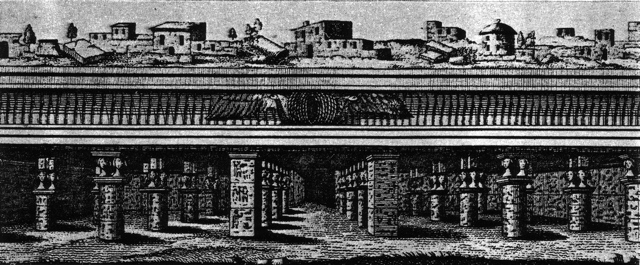
This colossal temple was
described in the past by authors such as Herodotus and Strabo, and
was said to contain 3,000 rooms full of hieroglyphs and paintings.
When Petrie first discovered the great artificial stone surface
(304m by 244m) in 1889, at the depth of several meters, he
interpreted it as the foundation of the labyrinth. New
evidence suggests that the stone plateau may in fact be the
roof of the great complex.
(More about this discovery)
|
|
 Abydoss
-
(The Osirion, Osireion, Strabo's Well). Abydoss
-
(The Osirion, Osireion, Strabo's Well).
As well as being the home of the great
Osireion (Strabo's
well), which shows several strong resemblances to the valley
temple at Giza, it is also the location of the primary southern-Egyptian
pre-dynastic to 2nd dynasty royal graveyard, which has revealed some
interesting artefacts and casts doubt on the traditional explanation of
early Egyptian history. The king-list from the Temple of Seti I
shows Seti I and his young son, the future Ramasese II
worshipping the cartouched names of 76 of their ancestors giving us one
of the foundations of Egyptian chronologies.
(More
about Abydoss and the Osireion)
|
|
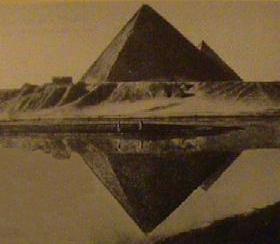 Egyptian Pyramids:
(Form and Function) Egyptian Pyramids:
(Form and Function)
Egypt is renowned for its pyramids, but what exactly was their
function to the builders? A look at the
evolution of the pyramid shape, and its many meanings.
Includes the following: The alignment of
Egyptian pyramids to Heliopolis, the
complicated issue of Snoferu's
three
pyramids, cultural similarities with other pyramid builders and the
relevance of the alignment of the 'memphite' pyramids to
Heliopolis.
( More
about Egyptian Pyramids)
|
|
|
 Karnak
- Karnak
-
(Thebes)-
This solar temple was first realised by Sir N. Lockyer, and dated by him
through archaeo-astronomy at 4,000 BC. The site originally included numerous
obelisks, four of which weighe up to 300 tons
each. The temple has been pillaged over the ages for its symbolic obelisks
and today only two remain standing with a third fallen.
Karnak was considered an 'Earth
Navel'
and Herodotus records a sacred connection
between Karnak and Delphi, The discovery of an
Omphalus
stone similar to that found
in
Delphi,
appears to support this connection.
(More about Karnak)
|
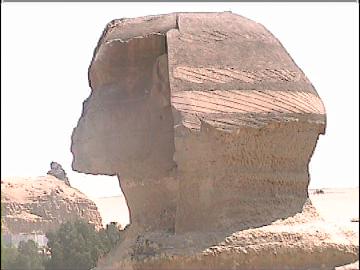 The Sphinx -
(Hwran Horemakhet - guardian of the atmosphere) The Sphinx -
(Hwran Horemakhet - guardian of the atmosphere)
We are unlikely to
ever resolve the argument over what the original form of
the Sphinx was or exactly when it was first fashioned,
but the essence of this ancient icon is perhaps partially revealed in its
ancient name. 'Hwran Horemakhet - guardian of the atmosphere'.
Evidence suggests that the Sphinx's face
has been re-carved at least once in history, (leaving it considerably
smaller than its body).
The features of the Sphinx profile have
been described as both
negroid and female.
(More about
the Sphinx) |
|
The
Ghiza plateau (Giza, Geeza)-
The Ghiza plateau has evoked more debate than any other ancient site in the
world. Throughout history, people have struggled to understand the
context of the site. The emergence and subsequent disappearance of such
superior masonry skills, combined with the imaginative confidence of the
designers resulted in one of the worlds most enduring archetypes of
human potential, along with an unprecedented level of speculation over
why, when, by whom it was originally constructed.
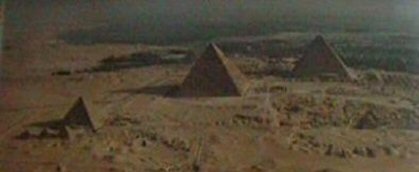
The high
level of interest over the origin and purpose of the Ghiza complex has
resulted in several widely varying theories, a situation which only
exacerbates the search for truth. The importance of Ghiza (and other
contemporary pyramids in the Memphis area), hinges primarily on the
level of geometry and astronomy expressed in the design of the layout or
proportions of the constructions.
Features
include: Analysis of construction
features, Historical references and observations, Identified geometry,
Pyramid alignments, The Sphinx, builders.
(More
about the Giza Plateau ).
(Beneath Giza) |
|
 Extreme
Egyptian masonry:
Egypt has produced some of the most incredible examples of stone-carving
in the ancient world. Even Petrie became convinced that the early Egyptian
masons had to be in possession of machinery in order to create the tens of
thousands of finely carved stone vases discovered. Extreme
Egyptian masonry:
Egypt has produced some of the most incredible examples of stone-carving
in the ancient world. Even Petrie became convinced that the early Egyptian
masons had to be in possession of machinery in order to create the tens of
thousands of finely carved stone vases discovered.
Clear evidence of
'Machine tools', 'Core drilling',
'Mass-produced lathe-cut vases', 'Seamless masonry' and even the use of 'concrete'
justifies a re-appraisal of the levels of skills of the Early-dynasty
Egyptians.
(Extreme
Egyptian Masonry)
|
|
 Egyptian astronomy - A knowledge of astronomy is present from the origin of the dynasties. It
is entwined into the very fabric of Egyptian religion, mythology and
architecture as far back as the evidence permits. Egyptian astronomy - A knowledge of astronomy is present from the origin of the dynasties. It
is entwined into the very fabric of Egyptian religion, mythology and
architecture as far back as the evidence permits.
The symbolic joining together of upper and lower Egypt under a single
crown, didn't prevent a distinction remaining between the orientation of
temples (pyramids)
in the north, which were built to face the cardinal points (and
therefore the equinoxes), whilst those in the south maintained a
preference for orientation to the solstices (such as
Karnack,
Denderra, Abydoss etc).
It is
an interesting fact that with the exception of one example, there are
no megalithic remains in Egypt. This singular megalithic site is the
Nabta
stone circle, which is significantly located on the Tropic of Cancer.
(More
about Egyptian Astronomy) |
|
 Egyptian
Geometry - Apart from the obvious example of the pyramids themselves,
the
Rhind
papyrus amongst others, clearly demonstrates the sophisticated level of
Egyptian mathematics at around 1650 BC. Egyptian
Geometry - Apart from the obvious example of the pyramids themselves,
the
Rhind
papyrus amongst others, clearly demonstrates the sophisticated level of
Egyptian mathematics at around 1650 BC.
It has been suggested that the placing of
the most significant Egyptian temple complexes such as at
Karnak and
Giza were
based on a knowledge of geometry and the concept of a spherical world. This
idea has support from Herodotus, who links sacred Egyptian sites with their
Greek and Libyan counterparts the 'Oracle centres',
which also show the same accurate placement according to observation of
longitude and latitude.
Not only do the
Ghiza pyramids have
geometry in their proportions, they are also just one of several
'Memphite' pyramid complexes aligned to Heliopolis.
(More about Pyramid
Geometry) (Prehistoric
Egyptian Geodesy)
|
The Oldest Known
Papyrus Roll - Blank Circa 2,900 BCE
"The ancient Egyptians had used rolls made of
papyrus from the early days of the Old Kingdom. The oldest known
papyrus roll was found in the tomb of Hemaka in
Saqqara, and dates to the 1st dynasty,
around 2900 BC. The hieroglyph for 'papyrus roll' existed already in
inscriptions from this period. The 1st dynasty roll was blank; the
oldest examples with writing dated from the 4th and 5th dynasties"
(Ref: Roemer, "The Papyrus Roll in
Egypt, Greece, and Rome," Eliot & Rose (eds) A Companion to the
History of the Book [2007] 84).
|
| The
Cultural Revolution of the First Dynasties: |
Pre-dynastic Nile-valley culture was
pastoral and agricultural, and shows no evidence of the expected gradual and
progressive development to the knowledge and skills of the fourth dynasty builders of Giza. Instead, many of these skills, along with religious, cultural and artistic
developments appear, seemingly overnight.
The development from 1st to
5th dynasty can be compared to progress from the industrial revolution to
present day.
Mendelssohn
(3) says of
this:
'...most Egyptologists are
inclined to think that at about 3,400 BC a large scale invasion of Egypt
took place. Where the invaders came from is not known. Burial customs and
certain architectural features are similar to the earliest Mesopotamian
civilisation but striking differences make it unlikely that this was the
origin of the invaders. It seems more probable that the rulers of Egypt and
of Mesopotamia had a common ancestry from which they derived common
traits...'
The answer varies according
to source, but it is reasonably accepted that this process did not take
place without some direct influence from one or many sources, such as Mesopotamia (Sumeria),
for example :-
Three Mesopotamian cylinder
seals of the later Uruk or proto-literate period have been found in Egypt:
One was from Naqada. From then onwards the Egyptians used the cylinder
seal - a Mesopotamian invention.
(1)
Mesopotamian motifs appear
in Egyptian art. On the ivory handle of a flint knife from
Abydoss, there
is represented the Mesopotamian hero Gilgamesh, subduing two lions, and
the same theme is repeated on a wall painting from Hierakonpolis,
belonging to one of the earliest brick buildings in southern Egypt.
(1)
There appeared suddenly in
Egypt the monumental style of building based on mud-brick, and we find
the ancient Egyptians abandoning reed, papyrus, palm branches and rush
matting in favour of sun-dried bricks made in wooden rectangular moulds.
And in using bricks in their buildings they also incorporated recessed
facades and pilasters such as were used in early Mesopotamian buildings.
(1)
Hieroglyphic writing is
first found on the slate palettes of late pre-dynastic times; where it
is already well advanced and is using ideograms and phonograms. This
first Egyptian writing must surely have derived from another, as yet,
unidentified source such as earlier Mesopotamian writing.
(1)
It is known that there
was a close connection between the early dynastic Egyptians and the
Sumerians. The Knife found at the Royal cemetery in Abydoss (right),
with its depiction of Gilgamesh, is proof enough, but the following
information suggests that the cultural link may have been stronger than
once thought.
The pre-dynastic Pharaohs of Egypt
were Sumerians from about 2780 B.C. At the time of Sargon (Sargon the
Great) Egypt was referred to as Mizir or Dilmun and his tomb (as a
predynastic Pharaoh) was found at the royal tombs at Abydos (in Egypt
today).
Egyptian hieroglyphs are a slightly
modified conventional form of the Sumerian diagrammatic picture-writing
which came into use during the rule of Menes and the 1st
dynasty pharaohs; they have the same phonetic values as their parent
picture-signs in the Sumerian.
Menes (Manj of Egyptian legend) (Manis of Mesopotamia) (Min or Minos of
Greek legend) erected Egypt into an independent kingdom and preserved its
independence within the Mesopotamian empire when he succeeded to the
throne after his father's death; Menes was the prince of Sumeria and
governor of the Sumerian Indus Valley. Menes annexed and civilized Crete
and extended his rule to the Pillars of Hercules and Britain.
Menes was the son of Sargon (who had a Queen named Lady Ash), or "Sargon
the Great" of ancient Mesopotamia and Menes and his dynasty referred to
themselves as "Gut"(Goth) (in Indus Valley seals) and "Bar" or "Par"(Pharaoh)
(as referred to in Egyptian records).
Menes' Egyptian inscriptions were written in Sumerian script (not the
later conventionalized hieroglyphs) and deciphered to match Menes'
Mesopotamian and Elam records as well as his official seals in the Indus
Valley (where he was a Sumerian governor there until he revolted against
his father (Sargon) and annexed Egypt). Menes had a son named Narmar or
Naram (Naram Enzu) whom he sent to the Indus colony of Edin as a viceroy.
(Cultural Connections
Between Early Dynastic Egypt and Sumeria)
|
List and Description of Egyptian Locations: |
|
Name. |
Description. |
|
Abu
Simbel. |
Temple complex, Moved in
pieces because of Aswan Dam. |
|
Abydoss. (Osireion). |
Underground structure
dedicated to Osiris. Temple of Seti-I above. |
|
Dendera. |
Temple dedicated to Hathor.
Several enigmatic engravings. |
|
Giza
(Ghiza) |
Giza plateau, Pyramid
complex, Sphinx. |
|
Heliopolis (Anu, On) |
The capital of northern
Egypt. Focus of pyramid alignment. |
|
Karnak
(Thebes) |
The capital of southern Egypt
and geodetic centre. |
|
Labyrinth (Lost) |
The Legendary 'lost'
Labyrinth re-discovered. |
|
Nabta Playa. |
Megalithic complex. Stone
circle. |
|
Osireion (Abydoss) |
Underground Temple dedicated to Osiris.
Temple of Sei I above. |
|
Saqqara |
Burial ground and home to the
first Egyptian pyramid. |
|
Sphinx. |
'The guardian of the
Athmosphere' |
|
Unfinished Obelisk. |
The largest stone ever cut,
but still in-situ, as found flawed. |
|
|